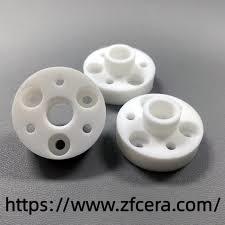Zhufa: Innovation in Ceramic Structural Parts for Energy and Electronics

Ceramic Structural Parts at Zhufa are redefining how engineers approach material selection, especially when high strength, durability, and thermal stability are required. Traditional metals and plastics often fall short in demanding applications such as electric vehicle systems, power modules, and energy storage components. By integrating ceramics into these designs, engineers achieve superior performance with reduced maintenance and extended operational life.
Replacing Metals and Plastics
Many industrial sectors are seeking alternatives to metals and plastics due to weight, wear, and temperature limitations. Ceramics provide high hardness and stiffness while remaining resistant to corrosion and chemical degradation. In automotive braking systems or electric battery housings, ceramic components reduce weight without sacrificing strength, improving efficiency and system longevity.
Designers also value the thermal insulation properties. Components that must withstand high currents or dissipate heat safely can benefit from ceramics' minimal thermal expansion and high resistance to deformation. This enables more compact, efficient designs that retain stability under fluctuating conditions.
Electric Vehicle and Power Electronics Applications
In electric vehicles, battery housings, cooling channels, and power modules increasingly rely on ceramics. Their ability to resist thermal stress while maintaining electrical insulation is critical for high-voltage systems. Components also support enhanced heat management, extending the lifespan of batteries and electronic modules.
Power electronics in renewable energy systems benefit similarly. Ceramics improve reliability in converters, inverters, and transformers exposed to high temperatures and voltage fluctuations. Their structural stability under repeated thermal cycling ensures safer, longer-lasting installations.
Performance and Design Flexibility
The convergence of durability and versatility allows engineers to explore complex geometries and integration strategies. Lightweight, rigid ceramic components can be customized for intricate assemblies that would challenge traditional materials. Heat-conducting or insulating sections can be incorporated into a single design, eliminating additional parts and assembly steps.
Production techniques such as precision machining and advanced sintering methods enable consistent quality even in intricate parts. Combined with design software, engineers can optimize mechanical and thermal performance while reducing waste and cost in the long term. Ceramic Structural Parts also contribute indirectly to sustainability. Extended lifespans reduce component replacement frequency, lowering environmental impact. Fewer failures reduce downtime, supporting uninterrupted operations in transportation, energy generation, and industrial machinery.
The adoption of ceramics represents a strategic shift in material engineering, moving from simple substitution to integrated performance enhancement. Systems designed with ceramics now exceed traditional expectations in endurance, reliability, and efficiency. Zhufa leverages expertise to provide Ceramic Structural Parts tailored for metal and plastic replacement in high-performance energy and electronic applications. Their approach ensures structural integrity, heat resistance, and precision, meeting evolving engineering demands. Visit https://www.zfcera.com/ to discover how innovative Ceramic Structural Parts are transforming energy systems and industrial designs with advanced material intelligence.
- Art
- Causes
- Crafts
- Dance
- Drinks
- Film
- Fitness
- Food
- الألعاب
- Gardening
- Health
- الرئيسية
- Literature
- Music
- Networking
- أخرى
- Party
- Religion
- Shopping
- Sports
- Theater
- Wellness

